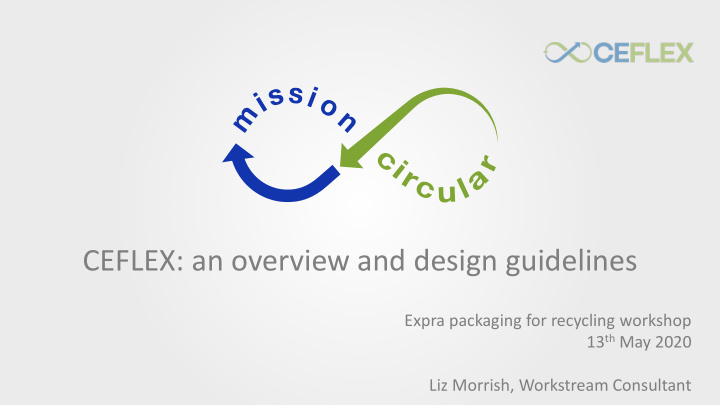



CEFLEX: an overview and design guidelines Expra packaging for recycling workshop 13 th May 2020 Liz Morrish, Workstream Consultant
Collaborating as the whole flexible packaging value chain, we aim to make all flexible packaging in Europe circular by 2025
CEFLEX Collaborative initiative of a European consortium of companies, organisations and associations Representing entire value chain of flexible packaging Designing and advancing better system solutions Further enhancing performance of flexible packaging in the circular economy
5 Steps to Build a Circular Economy for Flexible Packaging Drive collection of ALL flexible Identify solutions and develop packaging for sorting & capabilities to sort/recycle the recycling remaining fractions Sort the suitable mono-material End Markets for all recycled fractions so that they are flexible packaging materials available to be recycled Redesign multi-material These 5 Steps have been endorsed by flexible packaging to mono- the CEFLEX Stakeholders together with materials with existing a set of actions needed by each part of the flexible packaging value chain recycling streams
Designing for a Circular Economy Guidelines
Objective To provide information and tools to design flexible packaging in line with the requirements of the circular economy, with positive environmental and economic benefits Key activities • ‘Designing for a Circular Economy’ guidelines using a phased approach • A tool to enable the comparison of the economic and environmental lifecycle performance of different packaging formats and adopt the guidelines • A mechanism to review, update and revalidate the guidelines
Key aspects • To deliver a circular economy for flexible packaging then flexible packaging needs to be designed to be recyclable • Recycling is a key part of the changes needed, with opportunities for prevention, reduction and re-use • Recognise that flexible packaging is a very resource efficient format • Key role in protecting food and other products, preventing food waste and minimising use of resources • Objective is to design to be easily sorted once collected at end of life, made available for recycling and for recycled materials to be kept in the economy and used again • Packaging functionality should not be compromised
D4ACE guidelines aim to make flexible packaging circular by: • Giving clarity to the value chain so flexible packaging is designed to be suitable after use for collection, sorting and recycling • Contributing to increasing levels of recycling • Producing higher quality recycled materials to be kept in the economy and used in sustainable end markets
Phase 1 guidelines Phase 2 guidelines • • Structures that can be sorted and Structures that are not currently widely recycled using existing industrial scale sorted and/or recycled • technologies and processes Cannot yet be regarded as being ’designed • Regarded as ‘designed for recyclability’ for recyclability’ • • Supported by either test data or Testing needed to better understand commercial practices somewhere in sortability and/or recyclability, and to Europe determine impact of different elements of a • Focus on polyolefin-based structures structure
Phase 1 guidelines • Provide advice and guidance when designing and specifying consumer flexible packaging • Focus on polyolefin-based flexible packaging structures • Target audience is brand owners and retailers, whilst recognising the whole value chain has a role to play • Guidelines provide information on end of life processes • Guidelines cover key elements of a flexible packaging structure – with specific limits where applicable • Guidelines have been developed by, and for, the whole value chain
Guidelines provide information on end of life processes: • Packaging disposal including emptyability • Collection – essential step, CEFLEX calling for collection of all packaging • Sortability – key sorting steps to show how packaging behaves in a waste sorting environment • Recyclability – issues to consider, key steps in mechanical recycling process
Guidelines on elements of a flexible packaging structure • Material selection • For polyolefin-based structure preference for mono-PE and mono-PP • Thresholds for mono-PE, mono-PP and PO mixes • Other polymers – PET, PVC, Nylon, biodegradable and compostable polymers • Paper • Aluminium foil • Barrier layers and coatings – EVOH, PVOH, AlOx, SiOx • Metallisation
Guidelines on elements of a flexible packaging structure (continued) • Size, shape and construction • Density • Adhesives • Pigments • Additives and fillers • Print, inks and lacquers • Labels • Additional features
Guidelines to be launched to CEFLEX stakeholders end May 2020 • Executive summary • Technical report • Visual resources • Adoption and implementation of D4ACE guidelines by CEFLEX stakeholders Guidelines to be launched to wider value chain from June 2020 onwards • Website • PR and social media communications • Webinars • Collaboration with key industry bodies and associations
Phase 2 CEFLEX to undertake a programme of testing to better understand • Sortability and recyclability of multi-material structures currently not widely sorted/recycled • Impact of different elements of a flexible packaging structure on sortability and recyclability – inks, adhesives, coatings, etc. Results of testing will be used as basis for phase 2 guidelines
Thank you for listening and please join our “Mission Circular” Contact: Liz Morrish liz@ceflex.eu
Recommend
More recommend